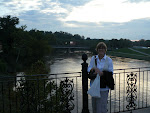 “B” is for BLOOD. I’m especially conscience of the importance of blood today, since I fasted for almost 24 hours before having three big tubes of blood drawn at my cardiologist’s office this morning. The lab work from my annual physical in December showed a slight elevation in my cholesterol, so my husband—an internist who specializes in
“B” is for BLOOD. I’m especially conscience of the importance of blood today, since I fasted for almost 24 hours before having three big tubes of blood drawn at my cardiologist’s office this morning. The lab work from my annual physical in December showed a slight elevation in my cholesterol, so my husband—an internist who specializes in  hypertension and preventive medicine—wanted a re-check. Especially since I always have good lipids and low blood pressure. On top of that, I had been dieting, exercising, and my resting pulse is only 60. All things considered, he wondered if there might have even been a labor error. So, before allowing my doc to put me on Lipitor, off I went for a more comprehensive evaluation… of my blood.
hypertension and preventive medicine—wanted a re-check. Especially since I always have good lipids and low blood pressure. On top of that, I had been dieting, exercising, and my resting pulse is only 60. All things considered, he wondered if there might have even been a labor error. So, before allowing my doc to put me on Lipitor, off I went for a more comprehensive evaluation… of my blood.Blood is essential to our life. The average adult body contains about 5 liters of blood, or about 1/5 of its total body weight. It’s a living flowing organ. Over 3 million red blood cells are made every second. But wait, isn’t this a series about Lent? What does blood have to do with spiritual things? Everything, because we are physical beings.
Ever wonder why some Christians sing, “Are You Washed in the Blood of the Lamb?” The concept comes from many places in Holy Scripture, including Revelation 7:14: “These are the ones who come out of the great tribulation and washed their robes and made them white in the blood of the lamb.” While beliefs vary from denomination to denomination as to just HOW Jesus’ blood saves us, the common belief is that it does, in fact, save us.
 And for Orthodox Christians, it’s essential to our spiritual health that we drink the blood of Jesus in Holy Communion. How does the wine in the chalice become the blood of Christ? It’s a mystery. But somehow it heals us, spiritually, just as blood that we receive in a life-saving transfusion heals us physically. And sometimes it even heals us physically. In one of the prayers we pray before Communion we ask that through the mystery of the Eucharist, Jesus will “sanctify my soul and body, my mind and heart and reins, and renew me entirely.” And in one of the prayers after communion, we ask that Christ’s body and blood will be for me “unto the healing of soul and body…. unto the enlightenment of the eyes of my heart; unto the peace of my spiritual powers….”
And for Orthodox Christians, it’s essential to our spiritual health that we drink the blood of Jesus in Holy Communion. How does the wine in the chalice become the blood of Christ? It’s a mystery. But somehow it heals us, spiritually, just as blood that we receive in a life-saving transfusion heals us physically. And sometimes it even heals us physically. In one of the prayers we pray before Communion we ask that through the mystery of the Eucharist, Jesus will “sanctify my soul and body, my mind and heart and reins, and renew me entirely.” And in one of the prayers after communion, we ask that Christ’s body and blood will be for me “unto the healing of soul and body…. unto the enlightenment of the eyes of my heart; unto the peace of my spiritual powers….”
And of course “B” is also for BREAD. Like this icon, which is called, “Christ the Bread of Life,” the bread we share from the chalice during the mystery of the Eucharist is also that living bread. How? Like the wine and the blood, it’s a mystery.
And while I’ve been one of many women who have baked the prosfora (holy bread) that is used for communion services at my church for many years—mixing together the ingredients that come from the earth: flour,
 water, yeast—I have also witnessed the miracle that happens during every Divine Liturgy when the bread becomes the Body of Christ. I don’t hunger for this life-changing bread nearly as much as I should, but during Great Lent, when I make even a small effort to fast, I find myself a little bit hungrier for God.
water, yeast—I have also witnessed the miracle that happens during every Divine Liturgy when the bread becomes the Body of Christ. I don’t hunger for this life-changing bread nearly as much as I should, but during Great Lent, when I make even a small effort to fast, I find myself a little bit hungrier for God.Next up? "C" is for....






























































2 comments:
Very nice post, Susan. I like your A, B, C...
I can relate to what you said about not hungering as much for the life-changing bread as much as you should. I feel the same way at times too. Thanks for the reminder on your earlier post about icons--from Saturday. I left a comment for you. Now back to work!
Post a Comment